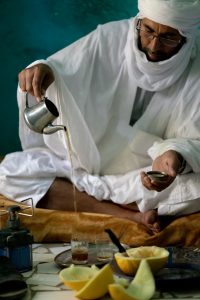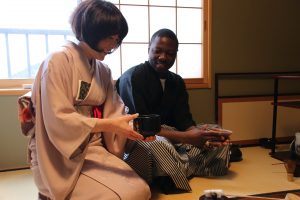By Abdel Ghader Khdeim
From the Magazine Africans

By Valerian Guillot
Tea ceremony is deeply rooted in the Japanese culture dating back to the 18th century, from China. Since then, it has become an intrinsic part of Japanese society. Similar culture is also found in the Maghreb region of Africa (Mauritania, Morocco, Algeria, Tunisia, and Sahara), which also dates back to the 18th century and mostly recoded to have been brought by colonial masters. Mauritania, a country that is hardly heard off in the northwestern part of Africa also has a deeply enshrined cultural green tea drink practice.
It has been two years since I was in Japan. I participated in the program ABE initiative of the Japanese government. During my two years in Japan, one thing reminds me of my country. Drink tea. Mauritanians normally drink green tea continuously on a daily basis and it is considered an important aspect of their daily lives. Mauritanians and Japanese tea ceremonies have a lot in common and a few differences.
Preparation
The Japanese tea ceremony requires graceful choreography and many hand movements; as a result people normally need to learn how to host tea ceremonies. It’s normally done in a quiet old fashioned Japanese house. The finest of green tea powder, which is most times produced from 30 years old trees, are used in the ceremony. The tea is prepared from three scoops of green tea powder which are placed into a bowl of hot water and mixed properly with a small handy broom-like object until it’s topped with foam, then it’s ready to be served for drinking. The tea is normally served once, presiding deserts or food. Sometimes different people drink from the same cup and sometimes different cups are prepared for everyone.
On the other hand, Mauritanians also go through the tea preparation learning process, mostly young lads are thought at home with months of daily practice on how to prepare and serve tea. The tea can be prepared anywhere people come together but mostly at home. People discuss a lot during the tea preparation process. Dried loosed gunpowder tea leaves shaped like pellets are used, which are mostly imported from China. They are brewed in a small teapot and poured in small glass cups. The tea is moved from glass to glass to produce foam inside the glass, the process continues until the glass is topped with foam. Sugar and mint with pungent, mild, clear aroma taste are added to the tea and tasted several times before serving to achieve optimal flavor. Three glasses are served with several minutes of interval. The first is considered the taste of life, the second is the taste of sorrow and the third the taste of death.

By Ahmed Osman
Respect
The tea ceremony in Japan is considered as a traditional practice of purity and peace. The ceremony is mostly performed in traditional houses and by people who are been trained to perform the ceremony. In a more formal tea drinking ceremony, the guest of honor who is also the first to drink asks to be excused by the others present to be the first to drink the tea. This shows humility and respect for others. Before drinking, the cup is also turned twice to show respect to the one who prepared the tea and acceptance of a cleansed process. Mauritanians also show a lot of respect during the tea drinking ceremony; elderly people are served the tea first to show respect and humility, age is of utmost importance during the Mauritanian tea drinking ceremony. They also show respect to the person preparing the tea by drinking from any side of the small glass which also shows acceptance of purity.
Hospitality
Green tea is served to every visitor in Mauritania, even family members as a sign of hospitality. It reflects joy and happiness. Rejecting tea in the Mauritanian culture is normally considered unacceptable. Japanese also take visitors for the tea ceremony. When visiting Japanese you are normally offered tea as a sign of hospitality. Most international visitors or tourists in Japan and Mauritania go for tea ceremonies to experience the process.
Friendship
Mauritanian green tea drinking culture is more camaraderie. It’s a sign of friendship that brings laughter and harmony. Different age groups come together and drink green tea for fun and relaxation as it’s the closest thing to alcohol many Muslims in the country drink. It helps to amplify discussions while bonding as age mates. In Japan, common green tea is drunk by the Japanese on a daily basis and the official tea ceremony is considered very formal. Mostly, people are invited or pay to attend the ceremony. In Mauritania, tea drinking is localized, while in Japan it’s formalized.
Finally, these two countries are miles away with not so much in common. However, there are always certain cultural activities wherever we find ourselves that seem very similar to where we come from.



Leave A Comment
You must be logged in to post a comment.